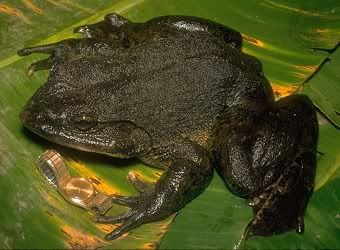 |
| Image from Enyclopaedia Britannica |
At 13 inches and 7 pounds, Conraua goliath lives up to its name. It is found in Equatorial Guinea and Cameroon. They tend to eat arthropods and fish, though they will eat anything smaller than their head that can be easily caught. ARKive has a picture of a Goliath frog eating... a Goliath frog. I didn’t find any indication of the frequency of cannibalism, though this article mentions it. It also talks about a 10-foot leap, but “it can only make three or four such bounds before giving in to exhaustion.” That is to say, they’ll be 30 feet away from you before they get tired.
The Goliath frogs, despite their large size, are difficult to find. The Cameroon Government allows the export of 300 individuals, though good hunters can find only a few dozen a year1. This does hint at the first cause of their endangerment: there’s a lot of meat on a 7 pound frog; they have been hunted for bush meat. They are exported for pet trade as well, but since they breed poorly in captivity, this collection does not help their numbers.
Scientists are trying to find more about their habits, and there was an extensive PIT-tagging project in 2004. However, legal aspects will have to come into play, since the Goliath frog is still unprotected.
1Though, for proper multiplication, it would be nice to have the number of good hunters around Cameroon.

1 comment:
I'd hazard to guess that most hunters are selling Goliath frogs as bushmeat *within* Cameroon rather than exporting them. For the pet trade, yes, export is probably more likely. I don't have any bushmeat data on Goliath frogs, but this will be interesting to look into.
~Natalie
http://critters.wordherders.net
Post a Comment